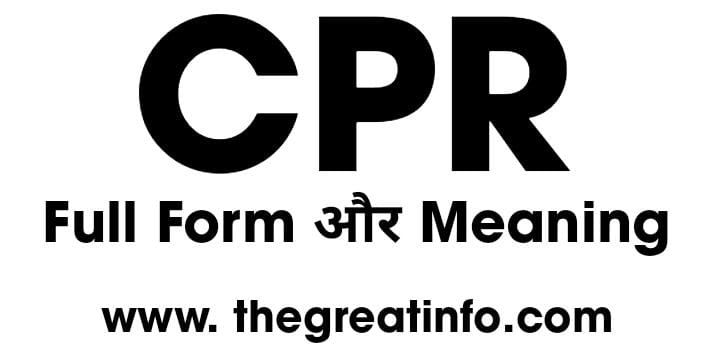CPR, or Cardiopulmonary Resuscitation, is a life-saving technique that plays a crucial role in emergencies. Whether it’s a sudden cardiac arrest or any situation where a person’s breathing or heartbeat stops, knowing CPR can make a significant difference. In this article, we’ll delve into the full form of CPR and its importance, with a special focus on the Hindi-speaking audience.
What does CPR stand for?
CPR stands for Cardiopulmonary Resuscitation. It is a combination of techniques designed to pump blood and oxygen throughout the body when a person’s heart and breathing have stopped. The term has evolved over time, with its roots deeply embedded in the medical field’s history. Understanding the acronym is the first step in grasping the importance of this life-saving technique.
Understanding the CPR technique
CPR involves chest compressions and rescue breaths, aiming to maintain blood circulation to vital organs until professional help arrives. It’s a technique that anyone can learn, and the process is more effective when initiated promptly. Let’s break down the steps involved in performing CPR:
- Check for responsiveness: Assess if the person is conscious and breathing.
- Call for help: Dial emergency services immediately.
- Start chest compressions: Perform chest compressions at the rate of 100-120 compressions per minute.
- Give rescue breaths: Administer rescue breaths to provide oxygen.
CPR in Different Languages
Interestingly, CPR is referred to differently in various languages. This reflects the cultural nuances associated with life-saving techniques. Understanding these linguistic variations can contribute to a more comprehensive approach to CPR education.
Significance of CPR Training
Knowing CPR is not just a skill; it’s a responsibility. The importance of CPR training cannot be overstated. It equips individuals with the ability to step in during emergencies, potentially saving lives before professional help arrives.
Common Misconceptions about CPR
Dispelling myths and misconceptions is crucial for encouraging more people to learn CPR. By addressing common misconceptions, we can ensure that individuals approach CPR with accurate information and confidence.
CPR Full Form in Hindi
In Hindi, CPR stands for “हृदय-फुस्फुसी पुनर्स्थापन” (Hriday-Fusfusi Punarsthapan). Understanding the full form in Hindi adds a layer of cultural context, making CPR education more accessible to Hindi speakers.
Benefits of Learning CPR in Hindi
Encouraging individuals to learn CPR in Hindi not only breaks language barriers but also makes life-saving knowledge more accessible to a broader audience. By promoting CPR education in Hindi, we can empower more people to take action in emergencies.
CPR Training Programs in Hindi
The availability of CPR courses in Hindi is essential for making education inclusive. Online resources and training programs in Hindi ensure that individuals can learn CPR at their own pace and convenience.
Real-life CPR Success Stories
Narratives of CPR successfully saving lives serve as powerful motivators. These stories highlight the impact of timely and effective CPR, inspiring readers to take the initiative to learn this life-saving technique.
Incorporating CPR in Everyday Life
CPR skills are not limited to specific settings. From home to the workplace, understanding how to perform CPR can be applied in various situations. Empowering individuals to incorporate CPR into their daily lives fosters a proactive approach to emergencies.
CPR and Healthcare Awareness in Hindi-Speaking Communities
Advocating for CPR awareness campaigns in Hindi-speaking communities is crucial. Bridging the gap in healthcare knowledge ensures that more individuals are equipped to respond effectively in emergencies.
CPR and Technology
Technology plays a role in enhancing CPR education. From mobile apps to virtual reality tools, various technological advancements make learning CPR more engaging and accessible.
Challenges in CPR Education
Identifying and addressing challenges in CPR education is essential for widespread adoption. Overcoming obstacles such as misconceptions, accessibility issues, and awareness gaps can contribute to a more informed and prepared community.
Conclusion
In conclusion, CPR is a life-saving skill that transcends language barriers. Understanding the full form of CPR in Hindi and advocating for widespread education in the Hindi-speaking community can have a profound impact on public health. Learning CPR is not just a task; it’s a responsibility that each individual can shoulder, contributing to a safer and more prepared society.
FAQs
- Is CPR only for healthcare professionals?
- No, CPR can be learned by anyone, and its basic principles are easy to grasp.
- How long does it take to learn CPR?
- CPR courses typically range from a few hours to a day, providing comprehensive training.
- Can I perform CPR without formal training?
- While formal training is recommended, basic knowledge can still make a difference in emergencies.
- Are there age restrictions for learning CPR?
- No, CPR training is suitable for individuals of all ages.
- What should I do if someone refuses CPR assistance?
- Respect their decision, but still call for professional help.

